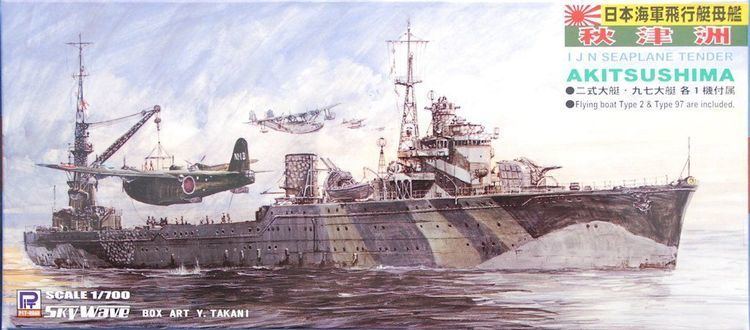Name Akitsushima Laid down 29 October 1940 Commissioned 29 April 1942 Construction started 29 October 1940 Length 115 m | Completed 29 April 1942 Decommissioned 10 November 1944 Launched 25 July 1941 Draft 5.4 m | |
Wreck dive japanese seaplane tender akitsushima
Akitsushima (秋津洲) was a seaplane tender of the Imperial Japanese Navy (IJN), serving during World War II from 1942 until being sunk in September 1944.
Contents
Design

In 1938, the IJN wanted to use their large-sized flying boats more effectively, because the Kawanishi H6K was the only aircraft able to hit Pearl Harbor directly from the Marshall Islands. However, the Marshall Islands did not have flying boat facilities at that time. Early in 1939, the IJN converted the oiler Kamoi to a seaplane tender. However, she was not able to repair seaplanes.

The IJN therefore planned two kinds of seaplane tenders which were included in the Maru 4 Programme. One was a 10,000-ton class flying boat carrier, the other a 2,400-ton class flying boat tender. These plans were not able to pass the assessment by the Ministry of Finance. These two basic plans were revived by the Maru 5 Programme in 1941. However, their construction did not begin. Therefore, the IJN planned a 3,500-ton class tender, which was a scaled-up model of the 2,400-ton class. The ships should be able to maintain, repair and supply seaplanes. The IJN intended to accommodate the flying boat by bow-up trim and slope at first, however this plan was cancelled and the Akitsushima class was equipped with a 35-ton crane. The IJN changed the design frequently, ending up with a displacement increased by 1,000 tons.
Operational service

Akitsushima was commissioned on 29 April 1942 and assigned to the 25th Air Flotilla, 11th Air Fleet. Two weeks later, she sailed to Saipan and Rabaul. After the U.S. invasion of Guadalcanal, Akitsushima arrived at the Shortland Islands on 16 August 1942. She was damaged by B-17E Flying Fortress bombers at Buka Island two weeks later.

Her repairs were completed on 5 January 1943, and she was dispatched to Kavieng, only to proceed to Jaluit Atoll in February. On 30 June 1943 she sailed to Paramushir for the evacuation of Kiska. She returned to Yokosuka in August and sailed via Shanghai to Truk. Here, she was slightly damaged by U.S. carrier planes which attacked Truk during Operation Hailstone. The following month, Akitsushima was assigned to the 14th Air Fleet and returned to Yokosuka for repairs. She also received repair ship facilities, because the repair ship Akashi had been sunk. Her refit was completed on 1 August 1944 and she was assigned to the 2nd Fleet.
In August 1944, she sailed to Kure and Imari, then to Kaohsiung and Manila, finally arriving at Coron Bay on 23 September 1944. Here she was sunk by aircraft of Task Force 38 the following day. Akitsushima was officially decommissioned on 10 November 1944.
